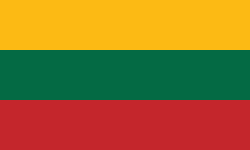Panevėžys (Panevėžys District Municipality)
 |
 |
The largest multifunctional arena in Panevėžys, Cido Arena, hosted the Eurobasket 2011 group matches.
The city is still widely known, if indirectly, in the Jewish world, for the eponymous Ponevezh Yeshiva.
Historical facts allow to state that the first seal of the city of Panevėžys appeared when the city self-government was established. It is clear that until the end of the 18th century, Panevėžys did not have the right of self-government, therefore it could not had its coat of arms. All the preconditions for the establishment of self-government arose during the period of the Four-year Seimas (1788–1792). In 1791–1792, most of the county centers, which previously did not have self-government rights and coat of arms, established them.
The coat of arms of Panevėžys, as well as other Lithuanian counties, has been changed, modified and banned several times over the past 200 years. There are 3 types of Panevėžys city seals, which were used in the early 19th century. The first appeared in 1801, the second was put into use in 1812, and the third in 1817. There is no doubt that all three seals under the double-headed eagle of the Russian Empire, which should have emphasized the city's affiliation with this state, depicted the old coat of arms of Panevėžys – a brick or stone building with three towers, later a brick gate with three towers and a powerful tower behind them with a Cyrillic letter P (П) on the roof – the first letter of the city.
After the Uprising of 1831, the old symbolism was erased from the seals of the county centers. Instead, a double-headed eagle prevailed in them unilaterally. It was only in 1845 that Emperor Nicholas I confirmed with his own hand the new coat of arms of Panevėžys County, at the top of which a silver obelisk was depicted in a blue field and a brown žagrė with a steel plowshare in the silver field at the bottom; the base of the shield was green-brown.
With the outbreak of World War I and the collapse of Russian oppression, most Lithuanian cities removed the symbols established by the Russian Empire and had returned to their historical coats of arms. At the beginning of the 1920s, two symbols were used in the coat of arms of Panevėžys in one field of a shield shape. At the top – two tied plant bundles, below them – a plough. Later, the žagrė was used instead of the plough.
The use of city coats of arms resumed in the post-war years only in 1966, when the Republican Heraldry Commission was established under the Ministry of Culture. The standard of the coat of arms of Panevėžys was proposed to be made by the artist Arvydas Každailis. Thus another version of the coat of arms of the city of Panevėžys appeared: two crossed white bundles of linen were depicted in the upper red field, and a white stylized plough in the lower blue field. Later, after adjusting the colors, it was decided to leave this coat of arms to the Panevėžys District Municipality.
The current coat of arms of the city of Panevėžys has been created taking into account the international practice of restoration of the historical coats of arms of the cities and the requirements of heraldry. The oldest coat of arms of the city was chosen to restore the coat of arms. The 1812 iconography of the seal was used as the best heraldically arranged on which a two-storey gates with an entrance opening on the first floor and two windows on the second floors are depicted. Above the gate – three towers, behind them, in the middle – a powerful tower.
As the historical colors of the coat of arms are unknown, it was decided to use the most common colors and metals in the heraldry of Lithuanian cities: silver (white), red, and as auxiliary – black. The current coat of arms of Panevėžys is a red brick building in the silver panel field, symbolizing the city gate. The coat of arms of Panevėžys was approved by a presidential decree on 11 May 1993. The author of the current coat of arms of the city standard is Arvydas Každailis.
Map - Panevėžys (Panevėžys District Municipality)
Map
Country - Lithuanian_Soviet_Socialist_Republic_(1918–1919)
 |
 |
| Flag of Lithuania | |
Germany had lost World War I and signed the Compiègne Armistice on 11 November 1918. Its military forces then started retreating from the former Ober Ost territories. Two days later, the government of the Soviet Russia renounced the Treaty of Brest-Litovsk, which had assured Lithuania's independence. Soviet forces then launched a westward offensive against Estonia, Latvia, Lithuania, Poland and Ukraine in an effort to spread the global proletarian revolution and replace national independence movements with Soviet republics. Their forces followed retreating German troops and reached Lithuania by the end of December 1918.
Currency / Language
| ISO | Currency | Symbol | Significant figures |
|---|---|---|---|
| EUR | Euro | € | 2 |
| ISO | Language |
|---|---|
| LT | Lithuanian language |
| PL | Polish language |
| RU | Russian language |















